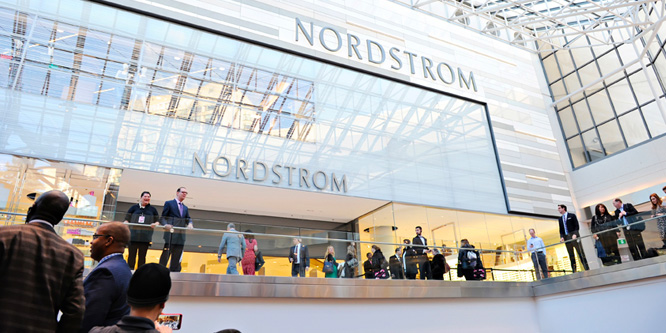
Nordstrom Rideau Centre, Ottowa, Canada – Photo: Nordstrom
March 3, 2023
Why did Nordstrom fail in Canada?
Nordstrom has decided to shutter its small base of stores in Canada, making it the latest U.S.-based retailer to face a chilly reception after expanding up north. The move is designed to help the chain focus on its core U.S. business amid the challenged economy.
The Canadian business, with six Nordstrom, seven Rack locations and the Nordstrom.ca website, accounted for three percent of sales.
“We entered Canada in 2014 because we believed it presented a compelling opportunity, and we are grateful for the many customer relationships we have built over the years,” said Erik Nordstrom, CEO, Thursday on the retailer’s fourth-quarter analyst call. “Despite our team’s best efforts, including multiple initiatives to improve our outcomes, our Canadian business has not been profitable. The impact from COVID drove further losses with no realistic path to sustainable profitability.”
Pre-tax charges ranging from $300 million to $350 million will be taken in the first quarter to wind down Nordstrom’s investment.
Among other setbacks, Lowe’s, in early February 2023, completed the sale of its Canadian operations, including 450 corporate and independent affiliate dealer stores, to private equity firm Sycamore Partners to likewise focus on U.S. operations.
The most widely-covered exit was Target’s closure of all its 133 Canadian stores in 2015, just two years after entering the country. Out-of-stocks, higher prices than in the chain’s U.S. stores, and overly-rapid expansion were cited as factors in the failed expansion.
Other U.S. chains facing stumbles in Canada include Best Buy, Sears, Big Lots, Sony, RadioShack and Express.
Other challenges for U.S. retailers operating in Canada include comparatively higher labor and real estate costs, widely-dispersed distribution, and idiosyncratic regulations, including the requirement that packaging must be in both English and French.
Assuming Canadian consumer tastes and trends are similar to the U.S. is also often cited as a common fault for retailers new to Canada. Ben Hanuka, a lawyer focused on commercial and franchise disputes, wrote in the Huffington Post, “While major Canadian shopping centres may seem to the untrained eye not much different from their US counterparts, significant differences in consumer patterns and preferences are alive and well.”
U.S. retailers finding success in Canada include Home Depot, Staples, Costco, Walmart and Starbucks.
- Nordstrom Reports Fourth Quarter 2022 Earnings, Announces Wind-Down of Canadian Business – Nordstrom
- Nordstrom (JWN) Q4 2022 Earnings Call Transcript – The Motley Fool
- Sycamore Partners Completes Acquisition of Lowe’s Canadian Retail Business – Sycamore Partners/PRNewswire
- Lowe’s Announces Sale Of Canadian Retail Business To Sycamore Partners – Lowe’s
- Lowe’s sells its Canadian ops to focus on the U.S. – RetailWire
- Target gives up on Canada – RetailWire
- The Dangerous Mistake U.S. Retailers Make in Canada – Huffington Post
- Woe Canada! Many U.S. retailers fail up north – CNN
- It’s oy, Canada, for many U.S. retailers – Associated Press/The Daily Record
- US Retailers Stumble In Canada – Financial Times
Discussion Questions
DISCUSSION QUESTIONS: Why couldn’t Nordstrom establish a foothold in Canada? Why does U.S. retail often fail to translate in Canada?
Poll
BrainTrust
Melissa Minkow
Director, Retail Strategy, CI&T
Ian Percy
President, The Ian Percy Corporation
Jasmine Glasheen
Content Marketing Manager, Surefront
Recent Discussions







Retail costs are generally higher in Canada and with their massive stores in premium locations, Nordstrom always struggled with profitability. This was exacerbated by largely replicating the U.S. proposition in a market that is different in so many ways. The straw that broke the camel’s back, however, is the fact that core U.S. operations are now under intense pressure financially and strategically. This means Nordstrom cannot afford to support an ailing foreign division. It has elected to cut its losses and run.
This is a surprising and perplexing move by Nordstrom, which from all outside appearances was doing well in Canada. But given Nordstrom’s immediate shut down, this was clearly not the case. While the specific reasons why U.S. chains fail in Canada are chain-specific, from my first-hand observations it’s that the Canadian stores often don’t live up to the store experience that Canadians see when they visit these same retailers in the U.S. Target is an excellent example. Canadians LOVE Target, but they didn’t like the often empty shelves and poor store experiences that were offered in the Canadian stores.
As someone who was part of the Target Canada expansion, I can wholeheartedly confirm how underestimated the shopper behavior differences are between U.S. and Canadian consumers. Retail strategy has to change quite drastically when expanding into Canada, despite what most think. Additionally, if there are formidable competitors in a certain category, the loyalty of Canadian consumers must be taken into account there — just because the loyalty exists in the U.S. doesn’t mean it’s there in Canada.
Nordstrom’s story is just another classic tale based on two consistent themes:
Nordstrom. Target. Sports Authority. The list goes on and on.
The population of Canada is about the same as California, but spread across a much greater territory (although with just a few large cities). This makes Canada difficult to service for a U.S. department store’s economic model. Then there is the demographics of how many people are economically within the range of shopping at Nordstrom within that region. All the other comments about cultural differences are valid as well but, at a macro level, it was a difficult effort to begin with.
Nordstrom Canada, like many retailers scaling in a new market, should have started small. Keeping Toronto and Vancouver locations would have been the smarter move as these Canadian cities are the most likely to shop Nordstrom. They are brand aware and savvy. As a Canadian, I shop Nordstrom and prefer the assortment and customer experience to the Canadian Holt Renfrew. The brand ambassadors were on the mark and it was a great alternative to the irrelevant assortment of The Bay and Saks.
In cities outside of Toronto and Vancouver, the luxury customer is segmented and loyal to Holt’s or SSENSE. Opening up hyper-localized Nordy locations after learning about how the market in Alberta differs from British Columbia and Ontario would have been a smarter move.
The decision to right-size comes from siloed leaders that don’t understand what the customer needs, no matter the region. This is not a customer-centric strategy and closing its Canadian operations tells us that Nordstrom doesn’t know what the customer wants. I will assure you that many Canadians want Nordstrom and these shoppers are concentrated in British Columbia and Ontario.
Furthermore, Nordstrom Rack is a disappointment across both the U.S. and Canada. They should have never opened their doors in Canada as the Canadian customer is TJX loyal. The retailer should be focused on finding the secret sauce to off-price success.
Liza, it is easy to tell that you and a couple others here speak Canadian. As one with both citizenships and having lived in the U.S. for 26 years, I can say the difference between the two cultures has never been more distinct. That’s not a good or bad judgement, it just is. Okay, some of it is judgement. But as Gene points out — culture rules.
Your read is spot on. Your recommendations might have been taken had an active investor not been in the mix as of last month. Mexico’s Liverpool has a 9.9 percent passive stake in Nordstrom and is an excellent operator; it’s unlikely they pushed for shutting down Canada.
IIRC Norstrom took over (location wise) from Sears Canada, which, in turn had taken over from the doomed “Eaton’s” experiment … it may simply have been a case of an offer seemingly too good to pass up. Vancouver might have the right demographics, but it’s also a (just) a few hours away from Seattle, Nordie’s home base, which leaves only Toronto. It would be a small start indeed.
On the surface, it is disappointing and unfortunate that Nordstrom has departed the Canadian market. We have seen many successful American-based retailers expand to Canada yet not establish a strategic operating model suited to the Canadian customer. A customer has different shopping preferences and behaviors than American shoppers, as Canada has unique provinces and cultures. Companies cannot expect a successful outcome by essentially copying and implementing similar go-to-market strategies from U.S.-based companies to international markets.
Additionally, the cost to serve the Canadian market, especially in the department store sector, is extremely high, and this has meant a significant hit to Nordstrom profitability. The department store sector is under substantial pressure to reassess its operating model, determine ways to remove costs from their business operations, optimize its store fleets to focus on the most profitable locations, and drive a customer-first approach to resonate with the modern consumer.
If you add the dimensions of adapting to an international market, then as we have seen with Nordstrom, it’s a significant challenge.
Nordstrom’s Seattle HQ is a two-hour drive from the Canadian border. But the difference between the two countries’ people could be measured in a twelve-hour flight.
As noted, the often-used case study for failure in Canada is Target. They lost $3 billion in three years and the CEO was fired. We can put their mistakes into several categories. Still, in each category, Target management (HQ to the Canadian border, 455 miles) thought they could copy and paste their U.S. business because “Canada is the same as the U.S.” Their most egregious assumption was about people, both customers and employees.
As I teach in my classes: “culture eats strategy for breakfast, lunch, and dinner.”
Nordstrom pulling out of Canada makes perfect sense when you consider the premium that Canadian consumers place on buying locally. A whopping 86 percent of Canadian customers prioritize shopping at small, local businesses. In light of this, retailers that plan to expand into Canada need to do so by partnering with a few hyper-local designers and artisans. Without those partnerships, department stores are seen as what they are: a challenge to local businesses.
Paradoxically, the reasons could be either the great strength of Canadian competitors like Holt Renfrew, Ogilvy’s, et al, or a general weakness in the Canadian market. Or it could be something as prosaic as the expense of serving isolated stores (they closed Anchorage years ago).
Beyond Nordstrom itself, it’s certainly bad news for the few cities — mostly downtowns — that had managed to land them … Canada is fast following the U.S. in having dying center-city retail.
Why U.S retailer fail in Canada is very retailer specific. Although, it seems a natural transition for U.S retailers to enter Canadian Market due to the common language, Canadian familiarity with U.S brands and many things in common.
Nordstrom struggled on keep its operation running because of its assumption that Canadian consumers are same as U.S consumers, its failure to establish strong online penetration, setting too high prices, not building assortment to local market and making no clear differentiation.
Often, U.S retailers overlook domestic competitors. There are several popular retailers in Canada that already have a stronghold on shoppers’ loyalty. U.S retailers can test the Canadian market, build brand awareness, get to know cross-border shopper, gain followers by first establishing online shopping functionality and gradually expand via key Canadian cities with smaller footprints.